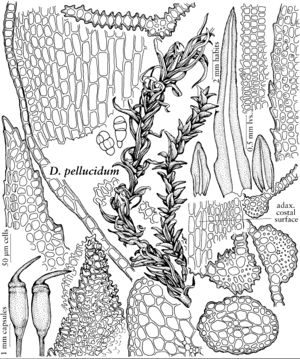Dichodontium pellucidum
Coroll. Bryol. Eur., 12. 1856,.
Stems 1.5–5.5 (–8) cm. Leaves 1–4 mm, apex narrowly to broadly acute to rounded-obtuse; margins weakly to strongly recurved in proximal half or sometimes nearly to the apex, generally smooth near the insertion, margins of leaf apex strongly papillose but without teeth; marginal laminal cells weakly papillose by projecting distal cell ends or smooth in proximal half of the leaf; median leaf cells with horned papillae on both surfaces; costal cells adaxially elongate (3–6:1), often smooth, clearly different from adjacent laminal cells. Specialized asexual reproduction occasional, by mullticellular ovoid to ellipsoidal gemmae borne on branched, rhizoidlike structures in the leaf-axils. Sexual condition dioicous. Seta 9–20 mm. Capsule 1.2–1.6 mm, not strumose, smooth when dry. Spores 13–20 (–25) µm.
Phenology: Capsules mature late fall–early spring.
Habitat: Moist soil on banks, wet cliffs, near streams, calcareous or acid rock
Elevation: low to high elevations (0–2300 m)
Distribution
Greenland, Alta., B.C., N.B., Nfld. and Labr., N.S., Nunavut, Ont., P.E.I., Que., Yukon, Alaska, Ariz., Calif., Colo., Idaho, Mich., Minn., Mont., N.J., N.C., Ohio, Oreg., Pa., Tenn., Utah, Wash., Wis., Europe, Atlantic Islands (Iceland)
Discussion
The leaf margins of Dichodontium pellucidum are strongly serrate-denticulate in the distal 2/3–3/4 of the leaf, varying to minutely serrulate to nearly entire in the proximal part. In D. olympicum there are no distant marginal teeth in addition to the even denticulations from apex almost to the leaf insertion. In D. pellucidum, such teeth are always present even though the denticulations may be nearly absent. A distinct hydroid strand is visible in leaf sections in the proximal half of the leaf in the larger stems, disappearing in the distal half together with a general loss of anatomical differentiation.
The rather smooth leaves of large-stemmed Dichodontium pellucidum without their typical robust papillae and generally from the northwestern United States may resemble Hyophila involuta. In H. involuta the width of the leaf at the insertion is nearly 1/2 the width of the leaf lamina at mid leaf. Its marginal teeth are located in the distal 1/4 of the leaf, not nearly to the insertion as in D. pellucidum. In D. pellucidum the leaf cells, in section, are convex and papillose, sometimes strongly so, on both sides of the leaf, whereas in H. involuta they only bulge on the adaxial side. Hyophila involuta has no papillae, and has clavate, stellate or dentate-elliptical “multi-horned” axillary gemmae, whereas the gemmae of D. pellucidum are simpler, cylindrical or globose with smooth walls and without projections.
Selected References
None.
